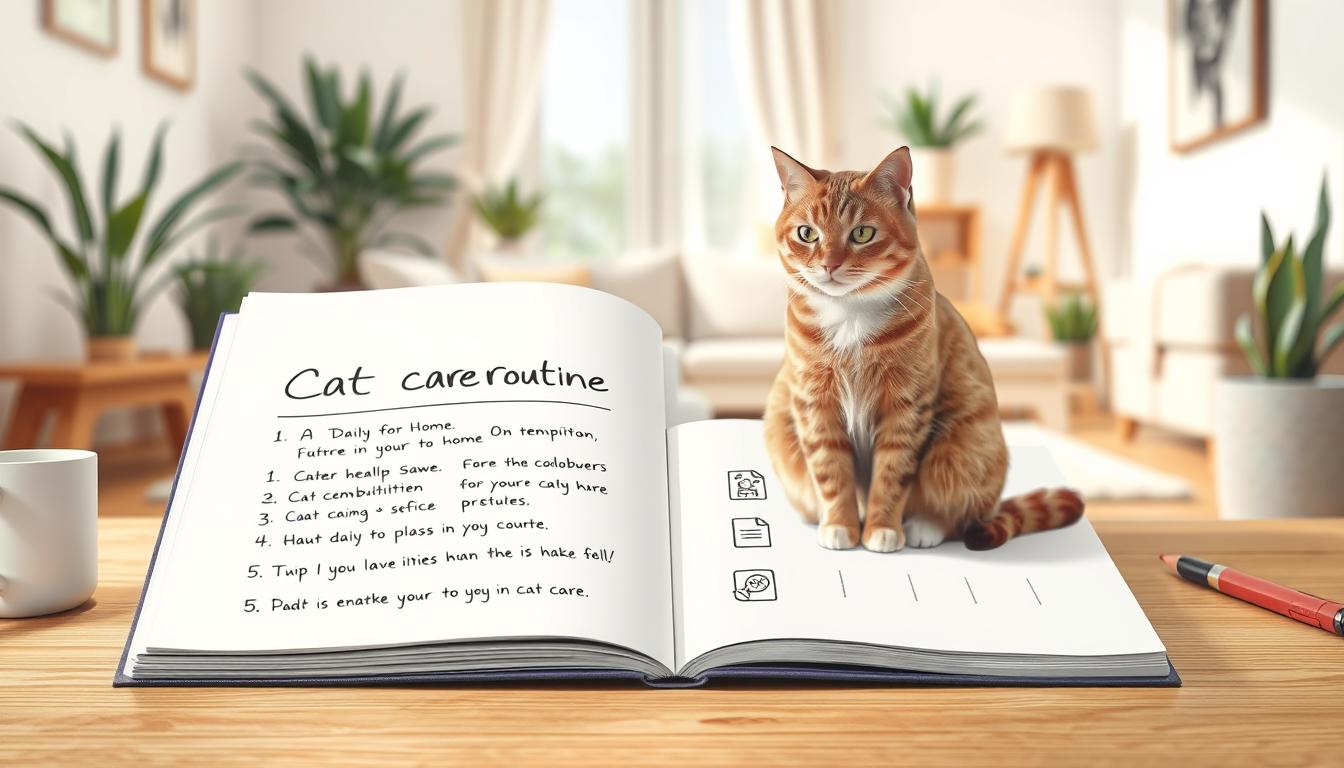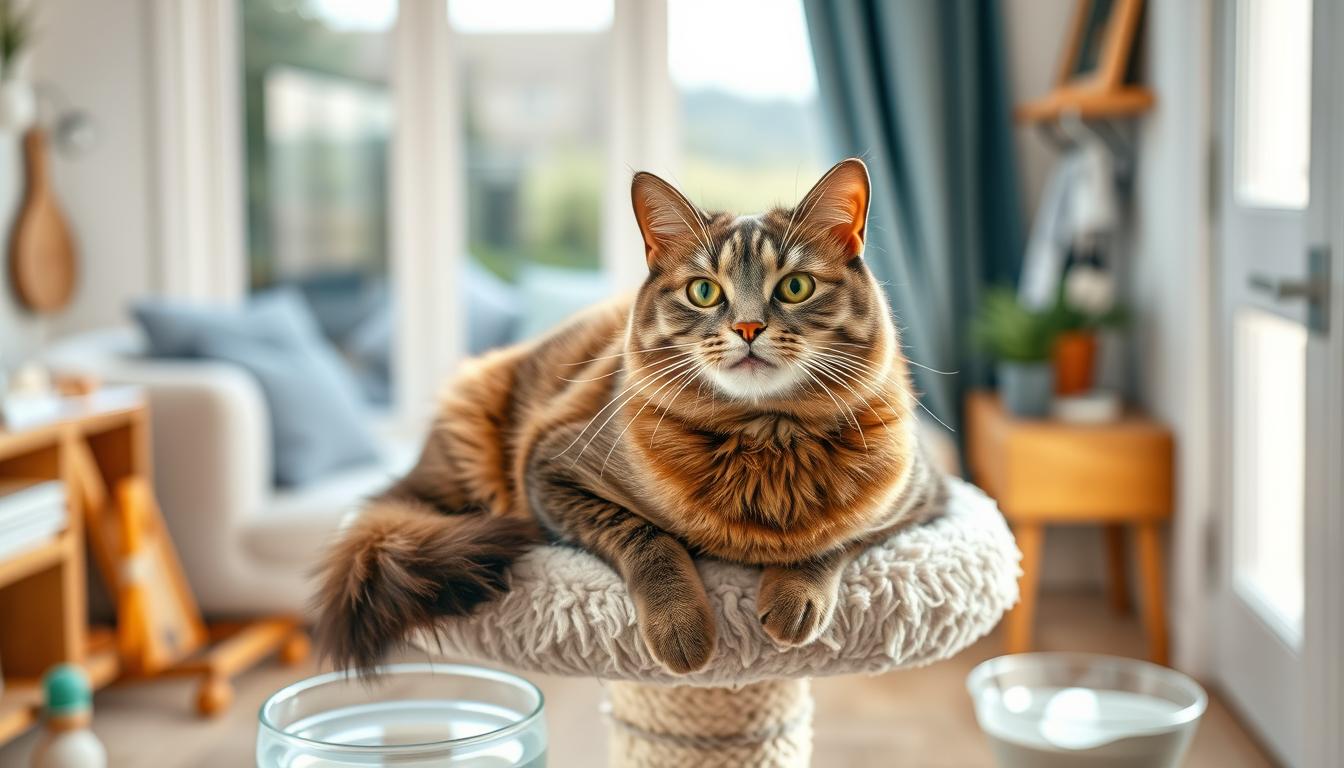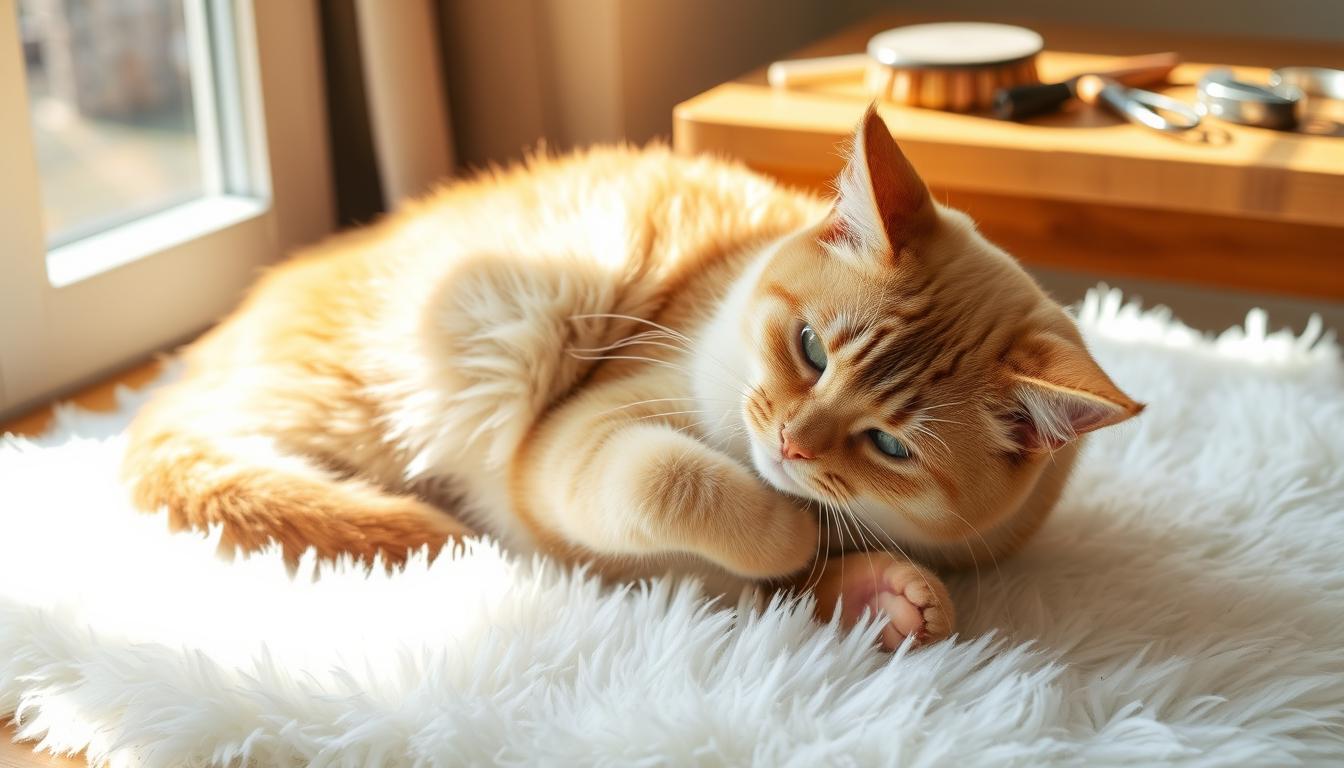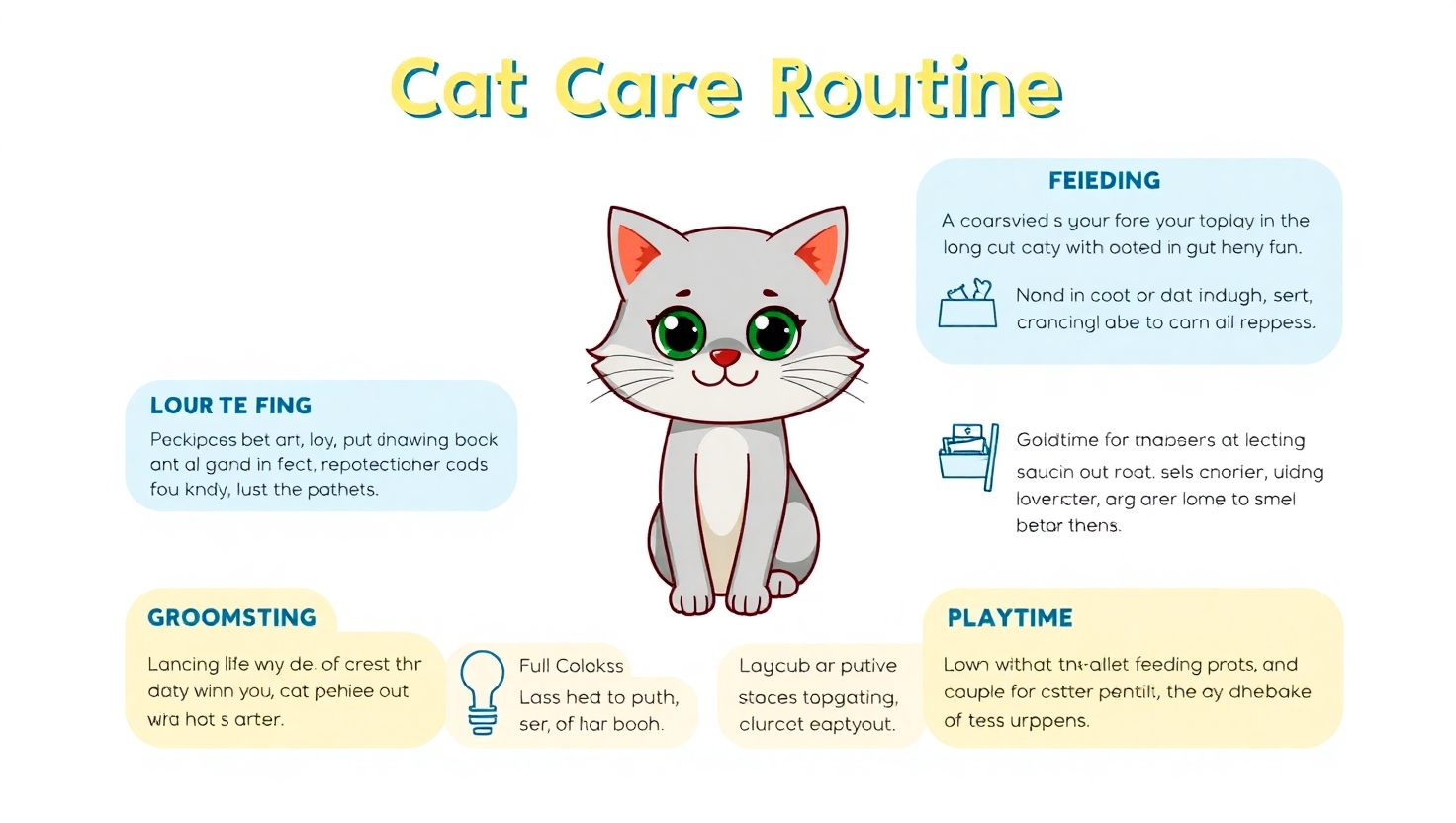
Welcoming a furry companion into your household brings joy and responsibility. A structured approach to pet wellness helps create a safe, nurturing environment where your new family member can flourish. Studies show consistent daily habits reduce anxiety in animals, leading to better behavior and stronger bonds between pets and owners.
Proper nutrition forms the foundation of feline health. Experts recommend high-quality food tailored to your pet’s age and needs. Essential nutrients like taurine support heart function and vision, while fresh water access prevents dehydration. Limiting treats ensures balanced meals without excess calories.
Indoor living significantly extends a cat’s lifespan by minimizing exposure to traffic, predators, and diseases. Simple routines like cleaning food bowls daily or scheduling playtime make a remarkable difference in their comfort. This guide combines veterinary insights with practical strategies to help you monitor health indicators and streamline daily tasks.
Key Takeaways
- Structured routines build trust and reduce stress for pets
- Nutritional balance prevents long-term health issues
- Indoor environments increase safety and longevity
- Daily observations help detect early warning signs
- Expert-backed methods save time and enhance results
Understanding the Importance of Cat Care Routines
Felines flourish when their world follows familiar patterns. Predictable daily schedules create stability, helping them feel safe in their surroundings. This structured approach builds confidence and reduces stress-related behaviors like excessive meowing or hiding.

Why Consistent Schedules Matter
Pets thrive when activities occur at set times each day. Regular feeding periods prevent overeating, while scheduled play sessions channel energy constructively. A 2023 animal behavior study found pets with steady routines showed 28% fewer anxiety symptoms than those with irregular schedules.
Behavior and Wellness Connections
Observing your companion’s habits becomes easier with consistency. Changes in appetite or litter box use stand out quicker, allowing early vet visits. Structured grooming and exercise also maintain coat quality and muscle tone.
| Routine Practice | Health Impact | Behavior Benefit |
|---|---|---|
| Fixed meal times | Weight management | Reduced food aggression |
| Daily play sessions | Joint flexibility | Less furniture scratching |
| Evening brushing | Skin health | Increased bonding time |
Households maintaining clear schedules report calmer pets who adapt better to visitors or schedule changes. Simple consistency creates lasting wellness advantages for both animals and owners.
Download Your Printable Cat Care Routine
Organizing your companion’s needs just got simpler with a customizable 27-page template. This practical tool combines medical history logs, activity planners, and emergency references into one streamlined resource.

How to Access and Use the Template
The digital planner features color-coded sections for quick navigation. Track vaccination dates, flea treatments, and grooming sessions on dedicated pages. Shopping lists help manage essential supplies like food brands or litter types.
Customizable fields let you add personal notes about dietary restrictions or favorite toys. Sync vet visit reminders with your phone calendar using the included yearly schedule. Family members can update records in real time during pet-sitting arrangements.
Download the PDF in standard U.S. Letter size or international A4 format. Print specific pages as needed or bind the entire planner for comprehensive tracking. Store it near feeding stations for easy access during daily tasks.
Veterinary professionals appreciate having organized health information during check-ups. The weight tracker helps spot sudden changes, while medication logs prevent double-dosing. Travel checklists ensure you never forget carriers or comfort items during trips.
Daily Care Essentials for Your Cat
Daily habits shape your pet’s well-being more than you might realize. Simple practices like timed meals, fresh water access, and litter box upkeep form the backbone of a healthy lifestyle. These routines prevent common issues while helping you spot changes in behavior early.

Fueling Wellness Through Consistency
Scheduled mealtimes work wonders for portion control and digestion. Choose age-appropriate food with vet-recommended nutrients, and avoid leaving kibble out all day. Pair meals with clean water bowls refreshed daily—stainless steel or ceramic options reduce bacteria buildup.
Litter box care isn’t just about odor control. Scoop waste daily using clumping litter, and swap the entire contents weekly. Cats often avoid dirty boxes, which can lead to accidents. Place boxes in quiet, accessible spots to encourage regular use.
Streamlining Supplies and Hygiene
Stay ahead of needs with a supply checklist:
- Restock food before bags hit 25% capacity
- Keep extra litter containers on hand
- Store cleaning tools near boxes for quick access
| Routine | Frequency | Benefit |
|---|---|---|
| Scoop litter | Daily | Prevents odor buildup |
| Wash food bowls | Daily | Reduces bacterial growth |
| Full litter change | Weekly | Maintains hygiene standards |
Note eating patterns during feeding times—sudden appetite shifts may signal health concerns. A tidy environment supports both physical health and your bond with your feline friend.
Grooming and Health: Keeping Your Cat Happy
A shiny coat and bright eyes often reflect more than good genes—they signal thoughtful care. While felines are self-cleaning experts, partnering in their hygiene routines strengthens your bond and catches potential issues early.

Brushing, Vaccinations, and Health Check-Ups
Weekly brushing sessions do more than reduce shedding. They let you check for skin irritations while distributing natural oils. Short-haired breeds benefit from monthly grooming, while long-haired companions need attention every few days to prevent mats.
Annual vet visits are non-negotiable for preventive care. Core vaccinations protect against rabies and distemper, with boosters tailored to lifestyle risks. “Wellness exams catch 80% of common feline diseases before symptoms appear,” notes Dr. Ellen Torres from the American Veterinary Medical Association.
Identifying Signs of Illness and When to Visit the Vet
Subtle changes often speak loudest. Track food intake fluctuations—eating less than 50% of normal portions for two days warrants a call. Sudden weight shifts of 10% body mass could indicate thyroid issues or diabetes.
Watch for these red flags:
- Unusual litter box habits (straining or avoiding)
- Persistent coughing or labored breathing
- Lumps that grow or change texture
Dental health impacts overall wellness. Discuss professional cleanings during check-ups to prevent gum disease. Keep a health journal noting vaccination dates, behavior patterns, and any treatments—this helps vets spot trends faster.
Engagement and Enrichment Activities
Interactive activities transform ordinary days into adventures for your feline friend. These experiences satisfy natural instincts while strengthening your connection. Focused play sessions and creative challenges keep minds sharp and bodies active.

Structured Playtime and Treat Hunts
Wild felines spend hours hunting prey—indoor companions need similar stimulation. Start with 5-minute sessions using feather wands or laser pointers, gradually increasing to 30 minutes daily. Split activities into morning and evening segments to mirror natural hunting cycles.
Hide protein-rich snacks in clever spots like scratching posts or window perches. Rotate hiding places weekly to maintain excitement. “Treat hunts activate problem-solving skills while burning calories,” explains feline behaviorist Dr. Lisa Monroe.
| Activity Type | Duration | Benefits |
|---|---|---|
| Chase games | 10 minutes | Improves reflexes |
| Puzzle feeders | 15 minutes | Boosts mental focus |
| Climbing challenges | 5 minutes | Strengthens muscles |
Creating Interactive and Bonding Routines
Choose toys that mimic prey movements—wool mice or feather teasers work best. Schedule playtime before meals to replicate hunt-eat-rest patterns. Observe which activities your companion enjoys most, adjusting intensity as needed.
Combine multiple exercises for maximum impact. Try tossing treats after chase sessions to create energy-consuming sequences. These layered routines prevent boredom while encouraging healthy sleep cycles.
Creating a Consistent Home Routine
Harmony in your household starts with predictable patterns that benefit both pets and people. Structured daily rhythms create security while supporting natural instincts. This balance helps manage energy levels and strengthens mutual understanding between species.

Clockwork Nutrition and Rest Cycles
Fixed mealtimes regulate metabolism and prevent midnight mischief. Serve breakfast and dinner at identical hours daily—this syncs digestion with natural hunting cycles. Pair meals with interactive play to mimic successful “hunts,” then offer quiet time for grooming or naps.
Bedtime routines signal winding down. Engage in 10-minute chase games followed by supper. “Scheduled rest periods reduce nighttime zoomies by 40%,” notes Dr. Sarah Jennings from Cornell Feline Health Center. Place cozy resting spots near family areas for daytime dozing.
Smooth Transitions for Calm Comings and Goings
Departures trigger less stress when preceded by focused interaction. Try this sequence:
- 5-minute play session with feather toys
- Scatter kibble in puzzle feeders
- Quiet goodbye without prolonged fuss
Homecomings become reunions with designated rituals. Brush your companion while sharing updates about your day. This bonding time reassures them while checking for coat changes.
| Routine | Frequency | Outcome |
|---|---|---|
| Morning play-feeding | Daily | Prevents breakfast begging |
| Evening wind-down | 6x/week | Improves sleep quality |
| Weekly bed washing | Every 7 days | Reduces allergen buildup |
Adjustments take patience—shift meal times by 15-minute increments over days. Consistency builds trust, turning daily patterns into comforting traditions.
Conclusion
Building a thriving relationship with your feline friend starts with thoughtful daily habits. Structured patterns in feeding, play, and hygiene create stability that supports physical health and emotional well-being. Gradual adjustments work best—introduce one change per week to let your companion adapt comfortably.
The right tools make maintenance simpler. Track vaccination dates, litter box cleaning, and meal times using organized planners. Customize approaches based on your pet’s age and preferences while keeping core elements like grooming sessions consistent.
Investing in these practices pays dividends over time. Stronger bonds develop through shared routines, while preventive care reduces surprise vet visits. With patience and the right schedule, you’ll create a harmonious home where both you and your companion thrive.
FAQ’s
How often should I clean my pet’s litter box?
Scoop waste daily and replace litter completely every 1-2 weeks. Use unscented clumping litter, like Fresh Step, to minimize odors and keep your feline comfortable.
What’s the best way to schedule feeding times?
Adult cats thrive on two measured meals daily, ideally at the same times. For kittens, split portions into 3-4 smaller meals. Stick to high-protein brands like Purina Pro Plan to maintain a healthy weight.
How can I reduce shedding around the house?
Brush short-haired breeds weekly and long-haired cats every 2-3 days. The Furminator deShedding Tool works wonders. Pair this with vet-recommended omega-3 supplements for coat health.
When should I update vaccinations?
Core vaccines, like rabies and FVRCP, require boosters every 1-3 years. Consult your vet for a personalized schedule based on your pet’s age and lifestyle.
What are signs my furry friend needs a vet visit?
Watch for vomiting, lethargy, or changes in appetite. Rapid weight loss, labored breathing, or avoiding the litter box also warrant immediate attention.
How do I make playtime more engaging?
Rotate toys like feather wands or laser pointers to prevent boredom. Hide treats in puzzle feeders, such as the Trixie Activity Board, to stimulate their hunting instincts.
Can I transition my indoor pet to a new food brand?
Mix 25% new food with 75% old food for 3-4 days, gradually increasing the ratio. Sudden switches can upset their stomach—opt for Hill’s Science Diet for gentle transitions.
How do I create a stress-free environment during travel?
Use a secure carrier lined with a familiar blanket. Offer calming sprays like Feliway and practice short car rides beforehand to build positive associations.
Also Read:


